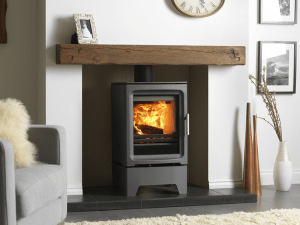.
How to Maintain Your Wood Burning Stove
A wood burning stove works at it’s very best when it is correctly installed, and is used in the way which it was intended. Lighting a wood burning stove correctly is one of the easiest things you can do, to ensure a great flame and a well functioning stove.
.
Lighting a Wood Burning Stove:
1. Adding some kindling is required to start the fire. Kindling are small pieces of chopped wood, which are used to help light a fire initially. Initially you should use kindling as a base, with one or two medium sized logs on top of them. Using medium sized logs (around 25/35cm long) as opposed to larger logs ensure a quicker growth of the fire. When a fire has matured, then it is possible to add larger logs.
.
2. You should light the kindling with the use of a fire lighter if needed. They will quickly light and start producing flames, which will help to burn the logs.
.
3. Start reducing the air intake when these logs are alight.

.
Ensuring Maximum Efficiency:
.
For an effective fire in your wood burning stove, you need to consider three elements:
.
Temperature – A high temperature helps ensure maximum efficiency. A solid fuel burns in an efficient way at high temperature with minimal smoke. Excessive smoke is a clue that the fire is not as efficient as it could be, and is not producing enough heat. Excessive smoke is also a possible indication that your flue could be blocked or the wood you are burning is damp.
.
Time – You should allow time for a fire to produce an efficient heat and flame. From starting a fire to it reaching it’s maximum heat could be anything up to 1hr. This figure does vary a great deal depending on the condition of your fire, the size and the quality of the wood you are using.
.
Turbulence – You should arrange the wood in a way, which ensures the air and combustion gases mix for an effective burn.
.
.
Operation & Maintenance:
.
There are various components, and associated elements that make up a wood burning stove. Each of these need to be considered, to ensure the operation and maintenance of your wood burning stove remains at the highest level possible. Things to consider:
.
Fire Window – An airwash system, which feature on all Charlton & Jenrick wood burning stoves will help ensure a cleaner window, which is much less likely to collect tar. Apart from an airwash system a fire window should fit well and have a snug fit. The fireproof rope, which acts as a gas tight seal should be in good condition – they are a wear item and so should be regularly inspected and replaced when necessary.
.
Throat Plate – It is essential that the flue is clear so smoke can leave safely, when the wood burning stove is in operation. Soot can sometimes fall down and collect on the throat plate, which increases the chance of deposits forming and possibly igniting. Due to this fact, you should ensure the throat plate is cleared on a regular basis, if the stove is in regular use.
.
Flue Outlet – The flue outlet is usually located on top or on the rear of a stove. The flue carries the gasses from the fire, safely up towards the chimney. As mentioned previously with the throat plate, you should ensure the flue is clear from any deposits forming, and also that the flue is correctly fitted, with no signs of damage. Building regulations require all products of combustion are discharged safely to the outside atmosphere.
.
Fire Bricks – Many wood burning stoves have fire bricks that line the floor and walls of the fire. They are designed to insulate the fire bed, which improves efficiency. You should regularly check for any broken bricks and replace when needed.
.
Ash Pans – Ash pans are designed to collect the ashes of burnt fuel, they should be cleared on a regular basis when getting too full. Wood burning stoves actually work best when there is a little amount of ash in the pan so it’s not essential to fully clean away, just ensure ash is kept under control.
.
.
Safety First – Essential Wood Burning Stove Tips:
.
Smoke Alarms – Ensure you check your smoke and carbon monoxide alarms on a regular basis.
Servicing – Make sure you get your stove serviced by a HETAS register installer.
At Night – Ensure you do not “turn down” your stove for the night. It’s much safer to put out when you go to bed.
Fuels – Use the right fuels for the stove, some are wood only, others are multi fuel. Ensure if you are using wood, that it is seasoned. Damp wood will not burn well, produce little heat and cause excessive tar and smoke.
Keep a Distance – Ensure that all combustibles are kept at a safe distance from a stove.








